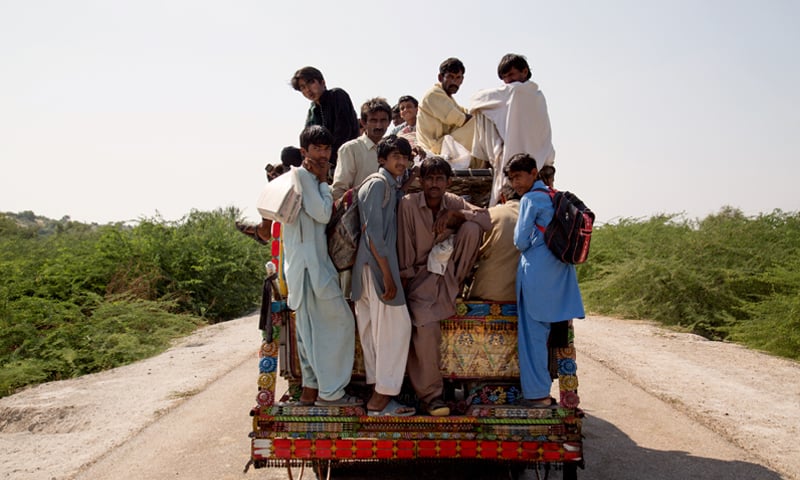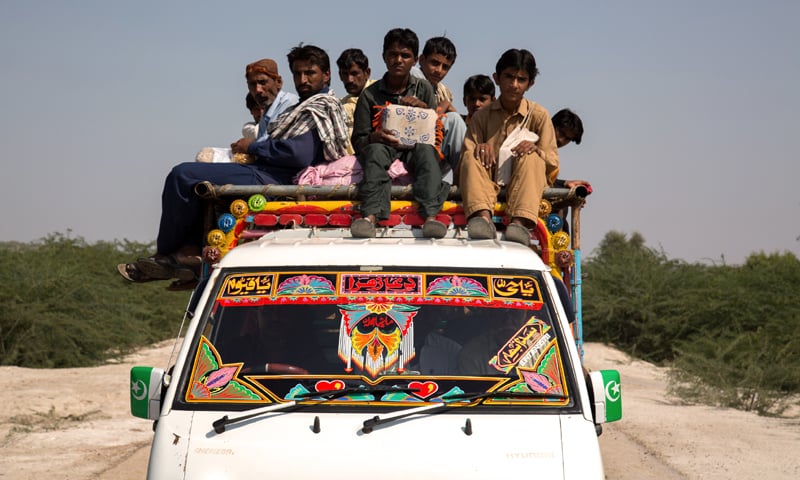Text and photos by Danial Shah
Heersingh Kohli wakes up at 4:00am every morning, gets dressed for school and leaves the house while it is still dark. After a half-hour walk through the desert, he reaches the main road and catches the local transport that will take him to school. Kohli is the first boy from his village Bhatari Wand [comprising 20 households] who has gone as far as the 10th grade of schooling.
Other than his passion for education, it is the economic factor that drives Kohli to take this journey every day. Just like other students who commute from different villages, Kohli does not have to pay for his commute to school. Even though there is a school located closer to his village, his quest for better education takes him to the Government Boys High School in Bhakuo, 32km away from his village. Out of the 485 students enrolled in the school, 300 commute every day from surrounding villages, even from as far as 60km.
Late last year, while on an assignment in Tharparkar, I got the chance to explore the school situation in the district. I looked for schools where education is a priority for the community. I was surprised to find out the level of commitment at the Government Boys High School in Bhakuo, 58km out of Mithi, where students commute every day from far off places by public transport for free.
An unconventional community initiative in Tharparkar goes a long way to ensure children attend school
So who pays for them? In 2005, the teachers of the school and community came together to convince private transporters to waive off the transport fee for students going to school from the village. “The students come from extremely underprivileged areas, and it is next to impossible for them to pay for transportation,” says Sikandar Azam Dar, the school in-charge.

“Hence we pushed the transporters to provide free transport for students on their way to school, or the villagers would not allow them to pass through the village,” says Sikandar.
The students come from 35 different villages in three administrative divisions connected to Bhakuo i.e. Mithi, Diplo and Islamakot. Eleven-year-old Ashoke from Bhatian Ji Vairy, a village 25km east of Bhakuo, says that a 45-minute bus ride takes him to school daily. Even though there is another school in his vicinity, Ashoke says “The school I go to has a better reputation and hence six of us go together from the village.” Just like Ashoke, 11-year-old Shavan commutes every day from his village Goga Vairy, 35km east of Bhakuo. His commute is a little over one hour.

Mohammad Azeem runs a cigarette stall in the main bazaar of Bhakuo and his son Saddam Hussain is in grade 6. “I regularly keep check my son’s performance as well as the teachers’ attendance to make sure everything is in order,” claims Azeem.
Sikandar, the school in-charge, believes that it is because of community involvement that they are able to provide quality education and free transport to students. “We cannot grow until we support each other,” he says.

The local transporters, however, are not happy with the situation. Ejaz runs a mini-van and crosses the village every day. “I transport total 20 to 25 students every day to school and because of this I suffer a loss of 1,000 to 1,500 rupees every day,” says Ejaz. “However, I try to accommodate students on the roof of the bus in order to keep seats free for passengers who pay, which makes up for the loss to some extent.”
After school hours, the students have to wait for their respective transport, sometimes for as long as two hours. “I complete my homework at the bus stop before my bus arrives,” Kohli tells me. He gets on his bus at 4:00 pm and reaches home in another two hours after which he helps his father doing errands before he prepares for school the next day.

According to Pakistan Education Statistics 2014-15, Academy of Educational Planning and Management (AEPAM), Ministry of Federal Education and Professional Training, 47 percent of Pakistan’s population aged five to 16 are out of school and poverty is one of the reasons. So a community initiative for making education accessible to children in rural areas is commendable indeed.



Published in Dawn, EOS, April 9th, 2017

















































